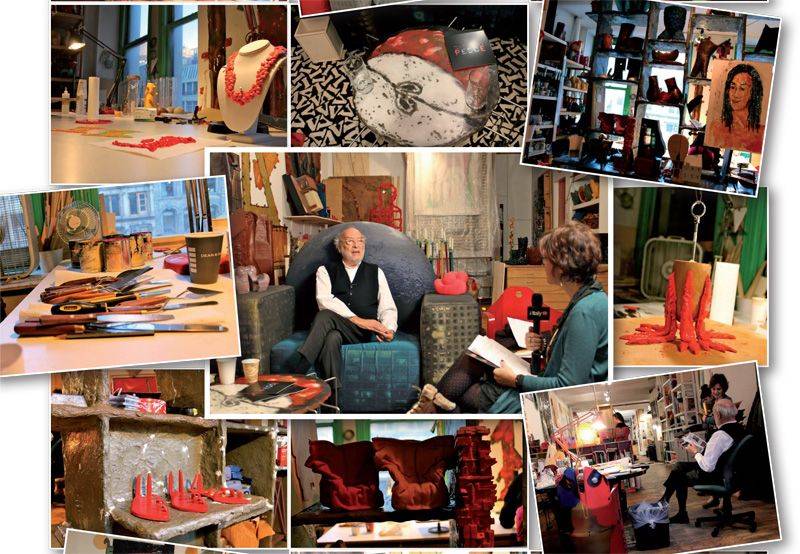Time, Diversity, and Provocation
Born in 1939, Gaetano Pesce sports oval glasses and a serious smile. He glides with ease in his hotbed of colors and ideas, a large space where the floorboards creak and the windows face Broadway. The old building in Soho was once home to artists and their studios.
The designer sits on “Notturno a New York,” one of his emblematic objects, a crescent moonfor a backrest and polyurethane skyscrapers for armrests that form a New York City nightscape.
The city is dear to him, yet “even if it’s the capital of the world, [he] can’t stay here for more than two weeks. It gets too repetitive,” he explains. “I’m lucky enough to have a job that permits me to travel a lot. And that gives me the right balance of this city.”
The objects in his studio look like fragments of history, little tesserae tracing Pesce’s past, present, and future. Time, diversity, error, the female figure—these are just some of the subjects that stoke our conversation in a studio that is literally swallowed up by his paintings and sculptures.
Provocation, for example. About “Italy on the Cross,” his irreverent installation that sparked arguments and set off polemics in and out of his home country, Pesce notes: “It’s a response to everything that is happening in Italy in the public realm...
It’s about an Italy that is struggling and should be looking at the enormous potential of the modern and contemporary world. Look at what Apple did. It ushered the future into the present and injected the world with something that helps us communicate.”
Pesce also talked about the formative time of his life. “I was a student of architecture and already part of the world of art... I hung out with designer Milena Vettore. She was at the school of industrial design in Venice and she opened up my mind... through her I met Cesare Cassina, a businessman with whom I founded the Bracciodiferro design team.
He invited us to do research and experiment in his factory.” “Cassina had foresight,” continues Pesce.
“He did a lot for Italian design. I learned a lot from him. For example, that culture in our day and age is ‘short’; it doesn’t try to span long historical periods and its values don’t last very long. Our age is composed of contradictions. Its contents emerge and vanish quickly.”
“Generally speaking, we’re at an impasse in history because things get repeated, more or less, and there’s not much innovation. I think that the way to rejuvenate the world might be to pass the torch to women.
They are more dedicated, committed, and active. Their psychological dexterity comes very close to the dexterity of our age. Men made extraordinary things in the past. Today they’ve exhausted their energy and devote their time to trifles... There are exceptions, naturally.”
On the subject of the transition from old to new, Pesce talked about his project at the MAXXI Museum in Rome. The exhibit—a major retrospective that will run form June 20 to October 26 and represents an important step towards ecognizing his work in Italy—is called “Il tempo della diversità” (The Time of Diversity).
“I think that once we have become diverse we want to communicate. And it’s right to do so. That’s what the name of the exhibit means.”
The subject of diversity, explains Pesce, leads us directly to the subject of men and women. “I’ve been working on this idea for 45 years and I wanted to celebrate it by showing how things have changed in the interim. Women still suffer from male prejudice. The exhibit will mostly speak to that problem.
There will be a 26-foot tall armchair outside the museum, in the piazza.
People will be able to enter it and they’ll be greeted by about 40 screens showing still images. Every screen will ask a question. One might ask which country doesn’t allow women to drive cars alone.
Visitors, if they want, will get he chance to answer a whole slew of questions. It’s a kind of provocation aimed at thinking about a very vital, relevant problem.”
Besides diversity, the other subject that comes up again and again in Pesce’s art is time. The subject has always fascinated him. “Another work shown in the retrospective will, I hope, elicit strong feelings,” says the designer.
“The last part of the exhibit is an installation about time. A 25’ x 25’ room with 20’ ceilings, like a walk- in refrigerator, will be set at a temperature of 33 degrees. You can enter inside and look around. It looks like a sun or an enormous clock of ice suspended, forming drops of water.
The point is that it will melt in the four months that the exhibit runs, and turn into nothing. But the drops will fall in a bucket and create a sound...there will be sensors that multiply the sound and make us feel time differently.”
Another provocation? “Yes, that’s what art is—provocation. But provocation isn’t an end in itself. It should push people to evolve...”
Before we leave his New York studio brimming with ideas, the artist shows us some of his resin sculptures, The Jewels of Gaetano Pesce. “Despite the fact that it’s relatively poor material,” he explains, “resin can be decorative.
These aren’t jewels that look back to the past. They say that a jewel can be made out of humble materials...” Bracelets, necklaces and brooches, soft and sinous to the touch, capture the light. Their shimmer enchants anyone with eyes to look.




































i-Italy
Facebook
Google+
This work may not be reproduced, in whole or in part, without prior written permission.
Questo lavoro non può essere riprodotto, in tutto o in parte, senza permesso scritto.